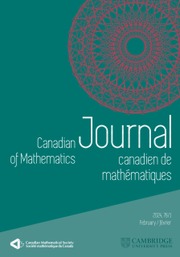No CrossRef data available.
Article contents
Rotation groups virtually embed into right-angled rotation groups
Published online by Cambridge University Press: 16 June 2025
Abstract
It is a theorem due to F. Haglund and D. Wise that reflection groups (aka Coxeter groups) virtually embed into right-angled reflection groups (aka right-angled Coxeter groups). In this article, we generalize this observation to rotation groups, which can be thought of as a common generalization of Coxeter groups and graph products of groups. More precisely, we prove that rotation groups (aka periagroups) virtually embed into right-angled rotation groups (aka graph products of groups).
MSC classification
Information
- Type
- Article
- Information
- Copyright
- © The Author(s), 2025. Published by Cambridge University Press on behalf of Canadian Mathematical Society
References
Antolín, Y. and Dreesen, D., The Haagerup property is stable under graph products. Preprint, 2013. arXiv:1305.6748.Google Scholar
Alonso, J.,
Finiteness conditions on groups and quasi-isometries
. J. Pure Appl. Algebra 95(1994), no. 2, 121–129.CrossRefGoogle Scholar
Alonso, J.,
Dehn functions and finiteness properties of graph products
. J. Pure Appl. Algebra 107(1996), no. 1, 9–17.10.1016/0022-4049(95)00028-3CrossRefGoogle Scholar
Basarab, Ş.,
Partially commutative Artin-Coxeter groups and their arboreal structure
. J. Pure Appl. Algebra 176(2002), no. 1, 1–25.10.1016/S0022-4049(02)00051-8CrossRefGoogle Scholar
Berlai, F. and de la Nuez, J.,
Linearity of graph products
. Proc. Lond. Math. Soc. (3) 124(2022), no. 5, 587–600.10.1112/plms.12434CrossRefGoogle Scholar
Bandelt, H.-J., Mulder, H., and Wilkeit, E.,
Quasi-median graphs and algebras
. J. Graph Theory 18(1994), no. 7, 681–703.CrossRefGoogle Scholar
Cooper, D., Long, D., and Reid, A.,
Infinite Coxeter groups are virtually indicable
. Proc. Edinburgh Math. Soc. (2) 41(1998), no. 2, 303–313.10.1017/S0013091500019660CrossRefGoogle Scholar
Cohen, D.,
Projective resolutions for graph products
. Proc. Edinburgh Math. Soc. (2) 38(1995), no. 1, 185–188.10.1017/S0013091500006313CrossRefGoogle Scholar
Davis, M. and Januszkiewicz, T.,
Right-angled Artin groups are commensurable with right-angled Coxeter groups
. J. Pure Appl. Algebra 153(2000), no. 3, 229–235.CrossRefGoogle Scholar
Dyer, M.,
Reflection subgroups of Coxeter systems
. J. Algebra 135(1990), no. 1, 57–73.10.1016/0021-8693(90)90149-ICrossRefGoogle Scholar
Genevois, A., Cubical-like geometry of quasi-median graphs and applications to geometric group theory. Ph.D. thesis, Université Aix-Marseille, 2017.Google Scholar
Genevois, A., Rotation groups, mediangle graphs, and periagroups: a unified point of view on Coxeter groups and graph products of groups. Preprint, 2022. arXiv:2212.06421.Google Scholar
Genevois, A.,
Special cube complexes revisited: A quasi-median generalization
. Can. J. Math. 75(2023), no. 3, 743–777.10.4153/S0008414X22000141CrossRefGoogle Scholar
Haglund, F. and Wise, D.,
Coxeter groups are virtually special
. Adv. Math. 224(2010), no. 5, 1890–1903.CrossRefGoogle Scholar
Reckwerdt, E.,
Weak amenability is stable under graph products
. J. Lond. Math. Soc. (2) 96(2017), no. 1, 133–155.10.1112/jlms.12054CrossRefGoogle Scholar
Soergel, M.,
A generalization of the Davis-Moussong complex for Dyer groups
. J. Comb. Algebra 8(2024), nos. 1–2, 209–249.10.4171/jca/83CrossRefGoogle Scholar


